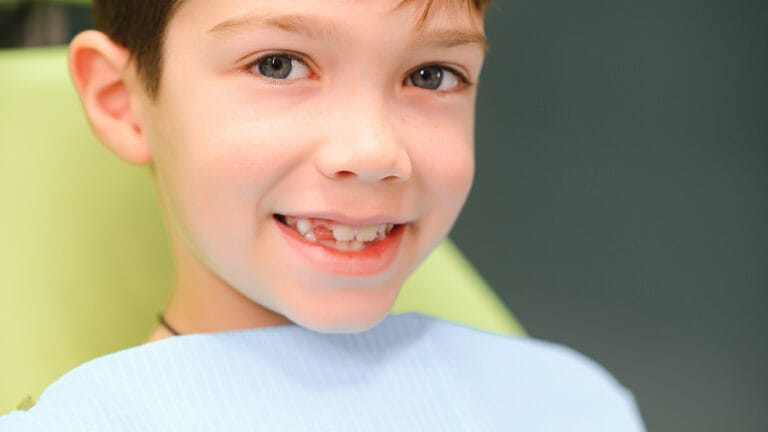Every bit of food and drink your child puts in their body first has to pass through their mouth. The teeth do the early work of breaking up food, making it safe to swallow and easier to digest. The health of your child’s teeth will impact their confidence and ability to chew comfortably and speak clearly. That’s why it’s important to balance the fun of snack time with lifelong dental health and support kids healthy teeth from an early age.
How Snacking Impacts Oral Health
Healthy dental habits begin as soon as your child’s first tooth emerges. That means brushing twice a day, flossing, and eating a nutritious, tooth-healthy diet. Food for healthy teeth and gums plays a key role in this process. Tooth decay at any stage, even when your child still has all their baby teeth, can lead to long-term dental issues later in life.
No matter how well teeth are brushed and flossed, your child’s teeth are covered in a thin layer of bacteria. Every time they eat or drink, those bacteria break down sugars and starches, producing acids that break down enamel, leading to cavities and tooth decay. Knowing how to keep your teeth healthy for kids is essential to prevent these issues before they start.
Over time, saliva washes the teeth clean, and pH levels in the mouth return to normal, but that only happens if there’s enough time between meals and snacks. The more time your child spends snacking, the more time their teeth are exposed to harmful acids, and the more damage is done to the tooth enamel. No matter what your child is snacking on, snacking should be in moderation. That said, some snacks are better than others—and choosing the best snacks for kids can make a big difference.
The Worst Foods For Your Child’s Oral Health
When choosing snacks for your child, some foods, even if they seem healthy, can lead to more tooth decay than others. Avoid foods high in sugar, sodium, starches, and unhealthy fats whenever possible. If it seems like junk food, it probably is, but these are some snacks you should avoid if you want to protect healthy kids teeth.
- Sticky and hard candies – These sugary treats produce higher levels of harmful acids than other snacks and stay in the mouth longer. Sticky candies like gummies find their way into the crevices between teeth, and hard candies are designed to be long-lasting. Your child might like lollipops, caramels, and fruit snacks, but bacteria like them even more.
- Starchy or bready snacks – The starches in these snacks break down similarly to sugar, producing the same harmful acids that damage teeth. Foods like crackers and potato chips get stuck in the spaces between teeth, where bacteria can continue to break them down over an extended period.
- Citrus fruits and juices – Oranges, grapefruits, lemons, limes, and other citrus fruits are a healthy part of a balanced diet, offering a variety of helpful vitamins and minerals, but they should be consumed in moderation. The combination of high sugar content and citric acid is like a one-two punch to your teeth’s defenses.
- Carbonated drinks – Carbonated sodas typically contain a high level of sugar, facilitating tooth decay. Even diet sodas or sparkling water contain dissolved carbon dioxide (for carbonation), making them more acidic than still water. The overconsumption of carbonated drinks leads to dental erosion, bacteria can stick more easily to the rougher tooth surface, and the risk of cavities increases. In addition, even if you avoid cavities, darker sodas can discolor your child’s teeth.
The Best Foods For Your Child’s Oral Health
The good news is that once you’ve eliminated the sugary candies and starchy snacks, a wide variety of tasty foods can help keep your child’s teeth healthy. These are some of the best snacks for kids who want strong, cavity-free teeth.
- High-fiber fruits – Look for fruits like apples and pears that are high in water and fiber. The water helps balance the sugars, and the high fiber content helps keep teeth clean. These fruits also stimulate saliva production, which helps wash the teeth clean once snack time is over. In addition, they contain essential vitamins that promote overall health and are excellent foods for healthy teeth.
- Crunchy vegetables – Fresh veggies like carrots, celery, broccoli, cucumbers, green peppers, and peas give kids the crunch they crave while keeping their teeth clean. Mix in some leafy greens high in water and essential nutrients—great food for healthy teeth and overall health.
- Dairy products – Cheese, milk, and other dairy products increase saliva production while providing calcium and phosphates that replace lost teeth minerals. Plain yogurt is a healthy alternative to pudding, gelatin desserts, or ice cream. Mix in some fruit or nuts to add flavor, texture, and variety.
- Sugarless gum – While gum isn’t a snack, it can sometimes do the trick and may have additional health benefits. The act of chewing and stimulation of taste receptors increases the production of saliva, which helps keep teeth clean. As long as it’s sugar-free, chewing gum can be a net positive for dental health, especially for kids healthy teeth on the go.
- Water – Drinking water helps to rinse away acids and leftover food scraps, neutralizing acids in the mouth. Water also helps keep the mouth and gums clean and hydrated.
If your child has orthodontic appliances, like braces, it’s even more important to avoid sticky and hard foods. Choose the best kid snacks for braces—soft fruits, cheese cubes, or yogurt can satisfy cravings without harming brackets or wires.
Support good oral health by focusing on a variety of nutritious, whole foods and minimizing the amount of sugary processed snacks your child is eating. Ensure your child builds good brushing and flossing habits, waiting at least 30 minutes between eating and brushing as the acidic environment weakens tooth enamel. Lastly, make sure your child visits the dentist twice a year. A pediatric dentist is specially trained to understand and treat young teeth, which can make going to the dentist more fun—and keep kids healthy teeth for years to come.






